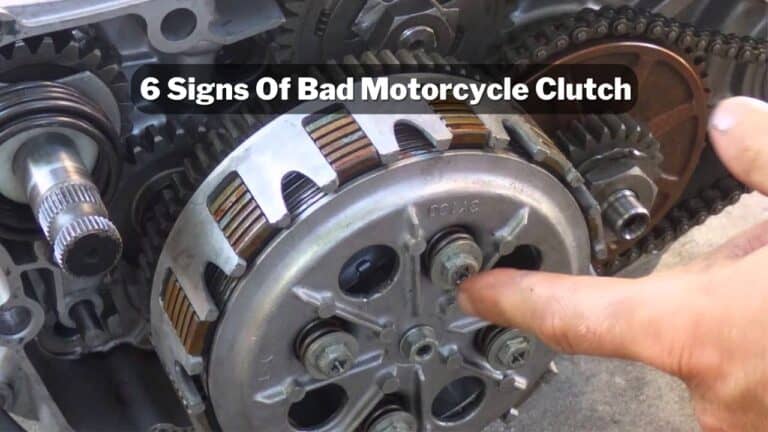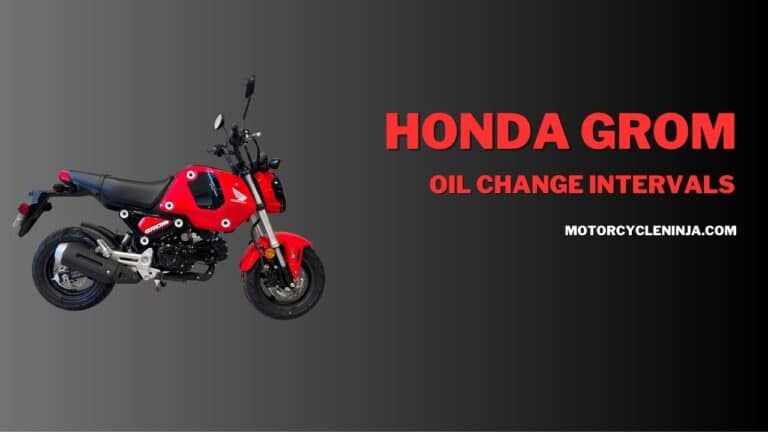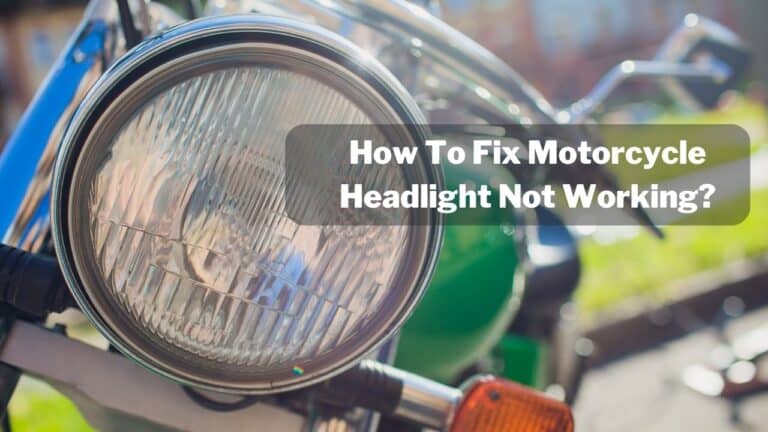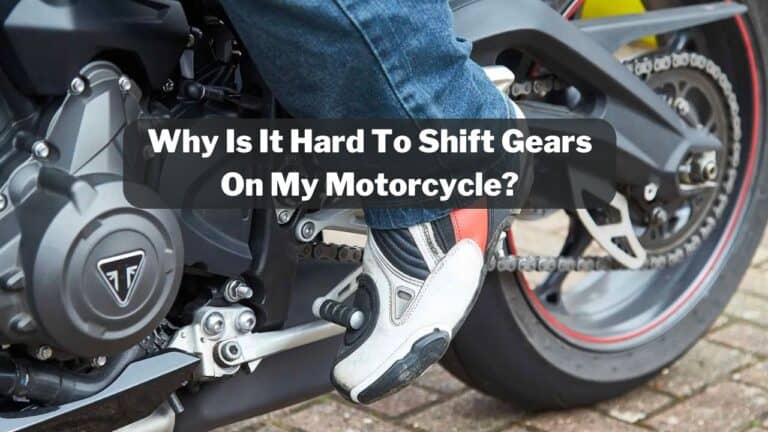10 Reasons Why Your Motorcycle Backfiring (Quick Fixes!)
Is your motorcycle exhaust making a gunshot sound or backfiring when decelerating? It’s bad for your motorcycle engine and environment. Exhaust backfiring/misfire is a common issue many motorcyclists and car owners face.
So, why does a motorcycle backfire? A motorcycle backfire occurs due to incomplete combustion of air-fuel mixture into the engine cylinder or leakage in the cylinder valves. Because of incomplete combustion, some unburnt hydrocarbons are left in the exhaust gases and explode when they come in contact with air, creating a loud gunshot noise in the exhaust pipe. The most common reason for engine backfire is the incorrect ratio or air-fuel supply.
Other reasons like exhaust pipe leakage, aftermarket exhaust, cylinder pressure leakage, dirty carburetor, clogged air filter, carbon fouling on the spark plug, and engine overheating also cause exhaust backfires. However, the issue can be easily fixed at home.
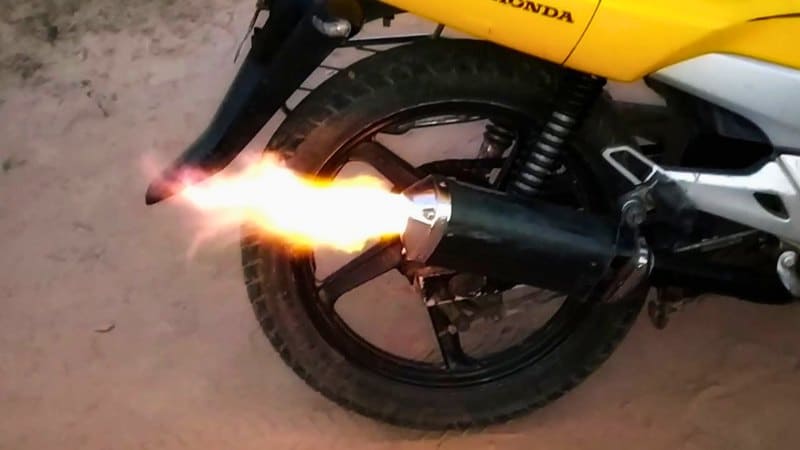
In this guide, we’ll look at various reasons why a motorcycle backfires and how we can fix that in a cost-effective manner.
Before that, let’s understand what engine backfiring is…
Table of Contents
- 1 What Is Engine Backfiring?
- 2 What Causes A Motorcycle To Backfire?
- 3 How To Fix Exhaust Backfiring On A Motorcycle?
- 3.1 1. Replace Air Filter
- 3.2 2. Tune Your Carburetor
- 3.3 3. Clean Your Carburetor
- 3.4 4. Clean Your Spark Plug
- 3.5 5. Use Stock Exhaust
- 3.6 5. Fix Exhaust Leakage
- 3.7 6. Perform Pressure Leak Down Test
- 3.8 7. Adjust Camshaft Timing
- 3.9 8. Change Engine Oil
- 3.10 9. Test Your O2 Sensor
- 3.11 10. ECU Reprogramming
- 4 Are Backfires Normal On A Motorcycle?
- 5 How Much Does It Cost To Fix Backfire On A Motorcycle?
- 6 What If Motorcycle Backfires Only When Decelerating?
- 7 What If Motorcycle Backfires Only When Accelerating?
- 8 Will Backfiring Affects The Fuel Mileage On A Motorcycle?
- 9 Is Backfiring Bad For Motorcycle Engine?
- 10 Conclusion
What Is Engine Backfiring?
A backfire is a loud pop or bang sound that occurs in the exhaust system. The motorcycle exhaust backfire is annoying and dangerous for your engine and environment.
Sometimes, your exhaust pipe starts emitting flame due to backfiring. It increases the temperature, which can melt or burn your motorcycle parts.
What Causes A Motorcycle To Backfire?
A motorcycle backfiring occurs because your engine receives too rich or lean air-fuel mixture. The correct amount of oxygen is required for the complete combustion of gasoline in the combustion chamber.
The ideal air-fuel ratio for a petrol engine is 14.7:1. Which means 14.7 parts of air are required for the complete combustion of 1 part of gasoline.
This ratio is also called the Stochiometric ratio. But, practically, it’s impossible to supply the ideal ratio every time.
But, if your air-fuel mixture is too rich, this results in exhaust backfire and decreased fuel economy.
The following are the main causes of exhaust backfiring on motorcycles–
- Aftermarket exhaust.
- Clogged air filter.
- Dirty carburetor.
- Faulty oxygen sensor.
- Faulty ECU (on fuel-injected motorcycles).
- Carbon fouling on the spark plug.
- Cylinder valve pressure leakage.
- Incorrect Camshaft position.
- Piston ring wear.
How To Fix Exhaust Backfiring On A Motorcycle?
If your motorcycle exhaust is making a loud pop sound or flame coming out from the exhaust, it’s a sign of exhaust backfiring. Please follow these methods to fix the backfiring problems-
1. Replace Air Filter
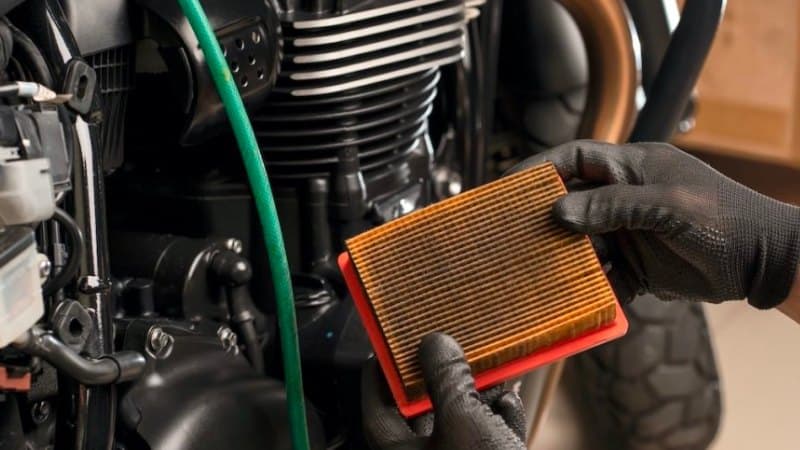
The primary cause of exhaust misfires is a too-rich air-fuel supply entering the combustion chamber. Your motorcycle engine runs rich when the combustion chamber has less air than the required value.
If dust particles clog your air filter pores, it stops the air intake to the combustion chamber, making the air-fuel mixture richer.
That’s why all motorcycle manufacturers recommend replacing air filters every 12 months or 15,000 to 20,000 miles.
If you ride in a dusty environment, replace your air filter every 6 to 8 months or 10,000 to 12,000 miles (whichever comes first).
Click here to read my guide on air filter change intervals for motorcycles in various conditions.
2. Tune Your Carburetor
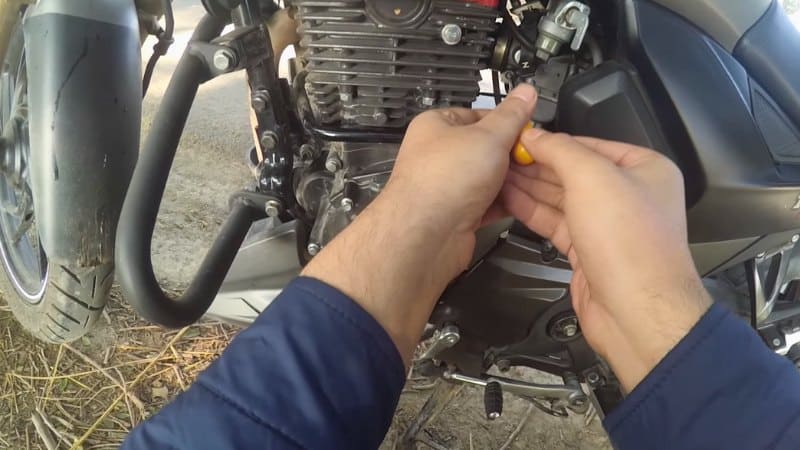
All modern motorcycles have fuel injectors instead of carburetors. But, this solution is applied on motorcycles with carburetors.
But, if you have an older model with poor fuel economy and exhaust backfiring problems, it could be due to inaccurate carburetor tuning.
Carburetor tuning requires experience and expertise, and I would advise you to seek professional help. Visit the nearest mechanic garage for carb tuning.
3. Clean Your Carburetor
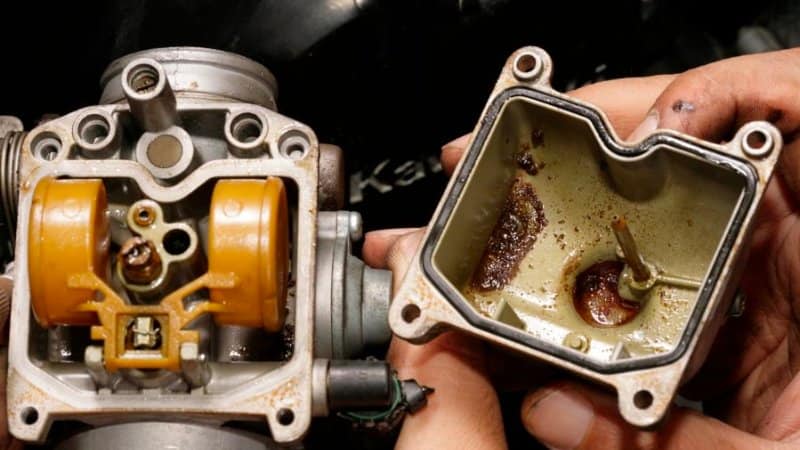
Again, regular cleaning is required for proper functioning if your motorcycle has a carburetor. The dust particles from the air and fuel clog the carburetor holes and throttle valves, disturbing the air-fuel ratio.
The incorrect air-fuel mixture ratio leads to incomplete combustion in the engine cylinder, resulting in an exhaust misfire. You should clean your motorcycle carburetor with WD 40 and a toothbrush.
4. Clean Your Spark Plug
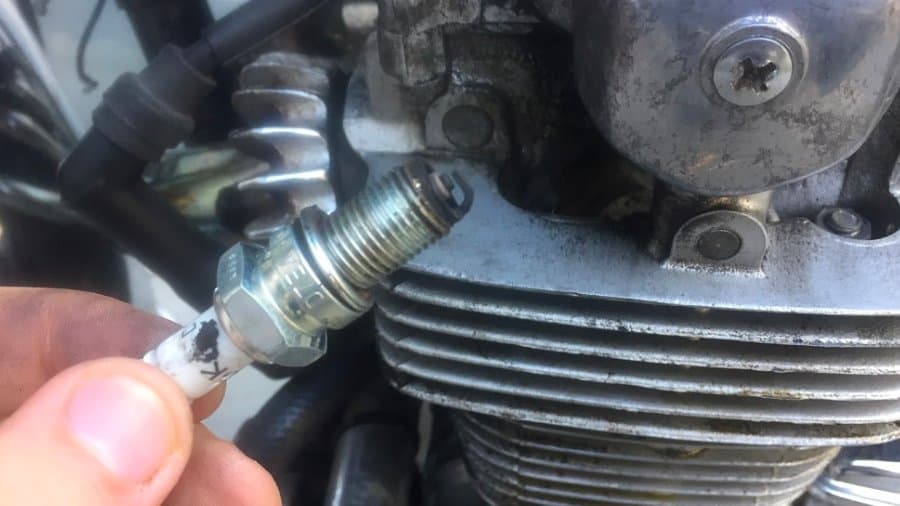
The spark plug plays a crucial role in your motorcycle engine. It ignites the compressed air-fuel mixture at the end of the compression stroke. The ignition timing should be precise for maximum power output.
But, due to bad fuel quality or piston ring wear, engine oil reaches into the combustion chamber, creating a carbon foul on the spark plug.
Due to carbon fouling, the spark plug doesn’t work at its full efficiency and creates a weak spark that leads to incomplete combustion.
These unburnt hydrocarbons explode when they come in contact with oxygen, resulting in a loud pop sound and fire flame from the exhaust.
Remove the spark plug and clean the tip of the plug with a clean cotton cloth. After cleaning, insert it into the cylinder head and tighten it fully, and your exhaust backfiring problem will be resolved.
5. Use Stock Exhaust
Many motorcyclists prefer installing aftermarket exhaust for louder sound and increasing horsepower. However, the stock exhaust is designed for balanced performance and optimum fuel economy.
When you decat your motorcycle and install it, the free-flow aftermarket exhaust could also cause an exhaust backfire. So, for the best performance with a smoother engine, please use the stock exhaust by motorcycle manufacturers.
5. Fix Exhaust Leakage
If your motorcycle exhaust pipe is too short and leaks, it creates a louder sound. Above that, air sucked from the leakage disturbs the actual data of the O2 sensor, and ECU tries to adjust the fuel injection on the wrong data sent by the oxygen sensor.
To fix this problem, first, tighten the exhaust header that connects with the exhaust manifold of the engine cylinder. Also, if your exhaust pipe has holes or gas leaks, please buy a new one.
6. Perform Pressure Leak Down Test
During the compression stroke, the piston increases the pressure and temperature of the air-fuel mixture to the designed value.
The spark plug ignites the high-pressure and high-temperature air-fuel mixture and explodes, pushing the piston downwards.
But, if there is pressure leakage from the inlet valve, exhaust valve, piston rings, or cylinder head, it results in incomplete combustion of hydrocarbons.
Perform a pressure leak-down test with a cylinder leakage tester kit and ensure it doesn’t exceed 20%. Pressure leakage between the 1-10% range is considered best for top performance.
If pressure leakage exceeds the acceptable value, your engine internals need repair. Please go to your nearest mechanic shop for engine repair.
7. Adjust Camshaft Timing
I’m sure you heard about Camshaft. It controls the opening and closing of inlet and exhaust valves in a four-stroke engine.
The camshaft is connected to your crankshaft via a timing chain. However, wrong timing creates problems and drops the engine performance.
Due to an incorrect position of the camshaft timing chain, your motorcycle backfires and faces lower mileage. To fix this, you need to adjust the camshaft timing.
The engine manufacturer provides cam timing marks for optimum engine performance. So, read your motorcycle workshop manual and match the timing marks when the piston is on Top Dead Center (TDC).
8. Change Engine Oil
The purpose of engine oil on a motorcycle is to lubricate the moving parts and keep the engine cool. If your motorcycle has low oil, the engine may overheat.
Engine overheating leads to pre-ignition, affecting the bike’s performance, and your motorcycle backfires.
Your motorcycle engine oil should be changed between 2,000 and 10,000 miles (depending upon the type of oil). I have published a detailed guide on motorcycle oil change intervals.
9. Test Your O2 Sensor
The oxygen sensor (aka O2 sensor) measures the proportion of oxygen in exhaust gases and sends signals to the ECU. According to that, your ECU controls the air-fuel mixture.
But, if your oxygen sensor is faulty, it won’t send correct data, and ECU supplies an air-fuel mixture that is too rich or too lean, which majorly causes exhaust backfiring problems.
Test the wire connections of the O2 sensor and ensure they’re intact. The ECU will trigger your Malfunction Indicator Lamp (MIL), a.k .a. Check Engine Light. You can scan with an OBD2 scanner.
Here’s the diagnostic trouble code for the faulty O2 sensor-
- P0130 – O2 Sensor Circuit – Bank 1 Sensor 1
- P0131 – O2 Sensor Circuit Low Voltage
- P0132 – O2 Sensor Circuit High Voltage
- P0133 – O2 Sensor Circuit Slow Response
- P0134 – O2 Sensor Circuit No Activity Detected
10. ECU Reprogramming
You might need ECU reprogramming when it doesn’t maintain an accurate air-fuel ratio. I would advise you to get your ECU reprogrammed at an authorized service garage for your motorcycle manufacturer.
Are Backfires Normal On A Motorcycle?
Yes, motorcycle backfire is normal up to a certain degree. However, if your exhaust creates a loud gunshot sound or exhaling flame, it’s dangerous for your engine.
It’s a sign of incomplete combustion of the air-fuel mixture. You should rectify the problem and fix it immediately.
How Much Does It Cost To Fix Backfire On A Motorcycle?
Generally, fixing backfires on a motorcycle costs between $150 to $1200, depending on severity. However, if your motorcycle is carbureted and goes for frequent service, a backfire occurs due to bad carburetor tuning—a carburetor tuning costs under $100.
If you’ve some experience, you can tune it yourself and save money. You should also replace your air filter every 12 months to maintain the correct air-fuel ratio.
What If Motorcycle Backfires Only When Decelerating?
It’s pretty normal if your motorcycle backfires when decelerating. It mostly happens if you’ve installed an aftermarket exhaust or your exhaust has any leakage. However, if the backfire continues, please follow the above solutions to fix it.
What If Motorcycle Backfires Only When Accelerating?
If your motorcycle exhaust backfires when accelerating, it’s the first sign of a bad air filter. The clogged air filter pores restrict the airflow, but the fuel injector supplies the same amount of fuel, which makes too rich air-fuel mixture. Clean or replace your air filter and notice whether the problem is fixed.
If backfiring continues after air filter replacement, please take your motorcycle to a mechanic shop.
Will Backfiring Affects The Fuel Mileage On A Motorcycle?
Exhaust backfiring is a sign of your motorcycle engine running too rich, drastically dropping fuel mileage. Follow the above-mentioned solution to diagnose the problem and fix it immediately.
Is Backfiring Bad For Motorcycle Engine?
Yes, backfiring is dangerous for your motorcycle engine. It increases the exhaust temperature and exhaust manifold.
If the backfire problem continues for longer periods, overheating will damage your exhaust valve, O2 sensor, and other components.
Conclusion
Too rich or lean air-fuel mixture leads to incomplete combustion, and these unburnt hydrocarbons in exhaust gases explode when they come in contact with air. I have mentioned all possible reasons for exhaust backfiring.
I hope you found this guide useful. Please share this guide with your motorcyclist friends. Do let me know if you’ve any questions in your mind.
